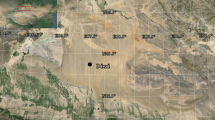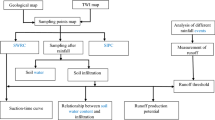Abstract
The threshold velocity is an indicator of a soil’s susceptibility to saltation activity and is also an important parameter in dust emission models. In this study, the saltation activity, atmospheric conditions, and soil conditions were measured from 1 August 2008 to 31 July 2009 in the Taklimakan Desert, China. the threshold velocity was estimated using the Gaussian time fraction equivalence method. At 2 m height, the 1-min averaged threshold velocity varied between 3.5 and 10.9 m/s, with a mean of 5.9 m/s. Threshold velocities varying between 4.5 and 7.5 m/s accounted for about 91.4% of all measurements. The average threshold velocity displayed clear seasonal variations in the following sequence: winter (5.1 m/s) < autumn (5.8 m/s) < spring (6.1 m/s) < summer (6.5 m/s). A regression equation of threshold velocity was established based on the relations between daily mean threshold velocity and air temperature, specific humidity, and soil volumetric moisture content. High or moderate positive correlations were found between threshold velocity and air temperature, specific humidity, and soil volumetric moisture content (air temperature r = 0.75; specific humidity r = 0.59; and soil volumetric moisture content r = 0.55; sample size = 251). In the study area, the observed horizontal dust flux was 4198.0 kg/m during the whole period of observation, while the horizontal dust flux calculated using the threshold velocity from the regression equation was 4675.6 kg/m. The correlation coefficient between the calculated result and the observations was 0.91. These results indicate that atmospheric and soil conditions should not be neglected in parameterization schemes for threshold velocity.






Similar content being viewed by others
References
Abulaiti, A., Kimura, R., Shinoda, M., Kurosaki, Y., Mikami, M., Ishizuka, M., et al. (2014). An observational study of saltation and dust emission in a hotspot of Mongolia. Aeolian Research, 15, 169–176.
Baas, A. C. W. (2004). Evaluation of saltation flux impact responders for measuring instantaneous aeolian sand transport intensity. Geomorphology, 59, 99–118.
Bagnold, R. A. (1941). The physics of blown sand and desert dunes. London: Methuen.
Barchyn, T. E., & Hugenholtz, C. H. (2011). Comparison of four methods to calculate aeolian sediment transport threshold from field data: Implications for transport prediction and discussion of method evolution. Geomorphology, 129, 190–203.
Barchyn, T. E., & Hugenholtz, C. H. (2012). Winter variability of aeolian sediment transport threshold on a cold-climate dune. Geomorphology, 177–178, 38–50.
Chen, W. N., Dong, Z. B., Yang, Z. T., Han, Z. W., Zhang, J. K., & Zhang, M. L. (1995). Threshold velocities of sand-driving wind in the Taklimakan Desert. Acta Geographica Sinica, 50, 360–367. (in Chinese).
Chen, Y. S., Sheen, P. C., Chen, E. R., Liu, Y. K., Wu, T. N., & Yang, C. Y. (2004). Effects of Asian dust storm events on daily mortality in Taipei, Taiwan. Environmental Research, 95, 151–155.
Chepil, W. S. (1945). Dynamics of wind erosion: I. Nature of movement of soil by wind. Soil Science, 60, 305–320.
Coakley, J. A., Cess, J. R. D., & Yurevich, F. B. (1983). The effect of tropospheric aerosols on the Earth’s radiation budget—A parameterization for climate models. Journal of the Atmospheric Sciences, 40, 116–138.
Darmenova, K., Sokolik, I. N., Shao, Y. P., Marticorenaet, B., & Bergametti, G. (2009). Development of a physically based dust emission module within the Weather Research and Forecasting (WRF) model: assessment of dust emission parameterizations and input parameters for source regions in central and East Asia. Journal of Geophysical Research, 114, D14201. doi:10.1029/2008JD011236.
Davidson-Arnott, R. G. D., Yang, Y. Q., Ollerhead, J., Patrick, A. H., & Ian, J. W. (2007). The effects of surface moisture on aeolian sediment transport threshold and mass flux on a beach. Earth Surface Processes Landforms, 33, 55–74.
Deoro, L. A., & Buschiazzo, D. E. (2009). Threshold wind velocity as an index of soil susceptibility to wind erosion under variable climatic conditions. Land Degradation and Development, 20, 14–21.
Dong, Z. B., Liu, X. P., Wang, X. M., Li, F., & Zhao, A. G. (2004). Experimental investigation of the velocity of a sand cloud blowing over a sandy surface. Earth Surface Processes Landforms, 29, 343–358.
Gautam, R., Hsu, N. C., & Lau, K. M. (2010). Premonsoon aerosol characterization and radiative effects over the Indo-Gangetic Plains: Implications for regional climate warming. Journal of Geophysical Research, 115, D17208. doi:10.1029/2010JD013819.
In, H. J., & Park, S. U. (2003). Estimation of dust emission amount for a dust storm event occurred in April 1998 in China. Water, Air, and Soil Pollution, 148, 201–221.
Iversen, J. D., & Rasmussen, K. R. (1994). The effects of surface slope on saltation threshold. Sedimentology, 41, 721–728.
Kawamura, R. (1951), Study on Sand Movement by Wind, Institute of Science and Technology Report 5, 95–112, Tokyo.
Kimura, R. J., & Shinoda, M. (2010). Spatial distribution of threshold wind speeds for dust outbreaks in northeast Asia. Geomorphology, 114, 319–325.
Kurosaki, K., & Mikami, M. (2007). Threshold wind speed for dust emission in east Asia and its seasonal variations. Journal of Geophysical Research, 112, D17202. doi:10.1029/2006JD007988.
Li, X. L., & Zhang, H. S. (2014). Observation and parameterization on dust emission over Horqin sandy land area. Beijing: Peking University.
Marticorena, B., & Bergametti, G. (1995). Modeling the atmospheric dust cycle: 1. Design of a soil derived dust emission scheme. Journal of Geophysical Research, 100, 16415–16430.
McKenna, N. C. (1989). Kinetic energy transfer through impact and its role in entrainment by wind of particles from frozen surfaces. Sedimentology, 36, 1007–1015.
McKenna, N. C. (2003). Effects of temperature and humidity upon the entrainment of sedimentary particles by wind. Boundary Layer Meteorology, 108, 61–89.
McKenna, N. C. (2004). Effects of temperature and humidity upon the transport of sedimentary particles by wind. Sedimentology, 51, 1–17.
McKenna, N. C., & Langston, G. (2006). Measurement of water content as a control of particle entrainment by wind. Earth Surface Processes Landforms, 31, 303–317.
Mckenna, N. C., & Sanderson, S. (2008). Humidity control of particle emissions in aeolian systems. Journal of Geophysical Research, 113, 14. doi:10.1029/2007JF000780.
Owen, R. P. (1964). Saltation of uniform grains in air. Journal of Fluid Mechanics, 29, 407–432.
Park, S. U., & In, H. J. (2003). Parameterization of dust emission for the simulation of the yellow sand (Asian dust) event observed in March 2002 in Korea. Journal of Geophysical Research, 108, D19. doi:10.1029/2003JD003484.
Prospero, J. M. (1999). Assessing the impact of advected African dust on air quality and health in the Eastern United States. Human and Ecological Risk Assessment, 5, 471–479.
Prospero, J. M., Collard, F. X., Moliniéj, J., & Jeannot, A. (2014). Characterizing the annual cycle of African dust transport to the Caribbean Basin and South America and its impact on the environment and air quality. Global Biogeochemical Cycles, 29, 757–773.
Ramanathan, V., Crutzen, P. J., Kiehl, J. T., & Rosenfeld, D. (2001). Aerosols, climate and the hydrological cycle. Science, 294, 2119–2124.
Ravi, S., & D’Odorico, P. (2005). A field-scale analysis of the dependence of wind erosion threshold velocity on air humidity. Geophysical Research Letters, 32, L21404. doi:10.1029/2005GL023675.
Sankey, J. B., Germino, M. J., & Glenn, N. F. (2009). Relationships of post-fire aeolian transport to soil and atmospheric conditions. Aeolian Research, 1, 75–85.
Shao, Y., & Lu, H. (2000). A simple expression for wind erosion threshold friction velocity. Journal of Geophysical Research, 105, 22437–22443.
Shao, Y., Jung, E., & Leslie, L. M. (2002). Numerical prediction of northeast Asian dust storms using an integrated wind erosion modeling system. Journal of Geophysical Research, 107, D244814. doi:10.1029/2001JD001493.
Shi, F., & Huang, N. (2010). Computational simulation of blown sand fluxes over the surfaces of complex microtopography. Environmental Modelling and Software, 25, 362–367.
Sokolik, I. N., & Toon, O. B. (1996). Direct radiative forcing by anthropogenic airborne mineral aerosols. Nature, 381, 681–683.
Spaan, W. P., & van den Abeele, G. D. (1991). Wind borne particle measurements with acoustic sensors. Soil Technology, 4, 51–63.
Spyrou, C., Kallos, G., Mitsakou, C. C., Athanasiadis, P., Kalogeri, C., & Iacono, M. J. (2013). Modeling the radiative effects of desert dust on weather and regional climate. Atmospheric Chemistry and Physics, 13, 5489–5504.
Stout, J. E. (2004). A method for establishing the critical threshold for aeolian transport in the field. Earth Surface Processes Landforms, 29, 1195–1207.
Stout, J. E. (2012). A field study of wind erosion following a grass fire on the Llano Estacado of North America. Journal of Arid Environment, 82, 165–174.
Stout, J. E., & Arimoto, R. (2010). Threshold wind velocities for sand movement in the Mescalero Sands of southeastern New Mexico. Journal of Arid Environment, 74, 1456–1460.
Stout, J. E., & Zobeck, T. M. (1997). Intermittent saltation. Sedimentology, 44, 959–970.
Udo, K., Kuriyama, Y., & Jackson, D. W. T. (2008). Observations of wind-blown sand under various meteorological conditions at a beach. Journal of Geophysical Research, 113, F04008. doi:10.1029/2007JF000936.
Vianaa, M., Querol, X., Alastueya, A., Cuevas, E., & Rodríguez, R. (2002). Influence of African dust on the levels of atmospheric particulates in the Canary Islands air quality network. Atmospheric Environment, 36, 5861–5875.
Wiggs, G. F. S., Atherton, R. J., & Baird, A. (2004a). Thresholds of aeolian sand transport: Establishing suitable values. Sedimentology, 51, 95–108.
Wiggs, G. F. S., Baird, A. J., & Atherton, R. J. (2004b). The dynamic effects of moisture on the entrainment and transport of sand by wind. Geomorphology, 59, 13–30.
Yang, X. H., He, Q., Ali, M., Huo, W., & Liu, X. C. (2013). Near-surface sand-dust horizontal flux in Tazhong—The hinterland of the Taklimakan Desert. Journal of Arid Land, 5, 199–206.
Yang, X. H., He, Q., Ali, M., Huo, W., Liu, X. C., & Miriam, S. (2012). A field experiment on dust emission by wind erosion in the Taklimakan desert. Acta Meteorol Sin, 26, 241–249.
Yang, X. H., Yang, F., Liu, X. C., Huo, W., He, Q., Ali, M., et al. (2016). Comparison of horizontal dust fluxes simulated with two dust emission schemes based on field experiments in Xinjiang, China. Theoretical and Applied Climatology, 126, 223–231.
Zobeck, T. M., Sterk, G., Funk, R., Rajot, J. L., Stout, J. E., & Pelt, R. S. V. (2003). Measurement and data analysis methods for fieldscale wind erosion studies and model validation. Earth Surface Processes and Landforms, 28, 1163–1188.
Acknowledgements
This research was funded by the China Special Fund for Meteorological Research in the Public Interest (GYHY201106043), the National Natural Science Foundation of China (41405013), and the Central Scientific Research Institute of the Public Basic Scientific Research Business Professional (IDM201103).
Author information
Authors and Affiliations
Corresponding author
Rights and permissions
About this article
Cite this article
Yang, X., He, Q., Matimin, A. et al. Threshold Velocity for Saltation Activity in the Taklimakan Desert. Pure Appl. Geophys. 174, 4459–4470 (2017). https://doi.org/10.1007/s00024-017-1644-5
Received:
Revised:
Accepted:
Published:
Issue Date:
DOI: https://doi.org/10.1007/s00024-017-1644-5




